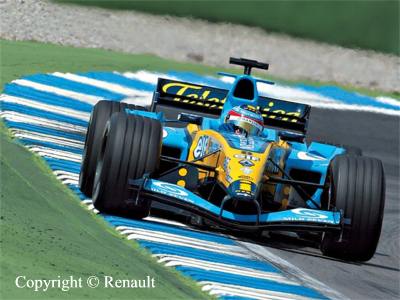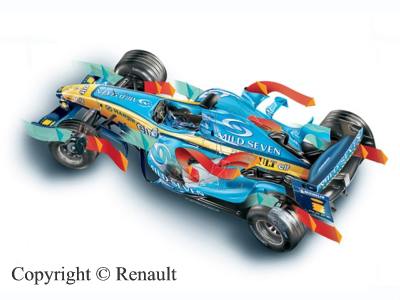Chassis and engine. Like all internal combustion engines, the termal efficiency of a modern V10 is around 30%, which means that when 850 bhp are transmitted to the rear wheels, over 2,000 potential horsepower are dissipated in the form of heat or in other ways (unburnt fuel). Some 50% of this loss takes the form of heat. Some 120 kW are absorbed by the oil and further 160 kW by the water. Over 30% of the remaining energy is lost as exhaust heat.
The reliability of a Formula 1 car is therofore dependent on its ability to cool the internal parts. The task of the engineers is to channel air as quickly as possible through the sidepods and radiators, even though this rate of flow is equivalent to no more than 15% of the car's actual speed. At 300 kph the air that passes through the radiators travels at mere 45 kph. Cooling is assured by carefully designed air inlets and outlets. Every opening, however, represents a cost in terms of lap time since downforce can vary by as much as 5% - the equivalent of 4/10ths of a second per lap - according to whether the maximum or minimum cooling configuration is being run.
Aerodynamics. Hot air is less dense than cool air and therefore produces less downforce.Suspension. If carbon fibre wishbones are exposed to exhaust fumes of up to 900°C, they can fail and lead to a big crash. Therefore the team uses periscope exhaust systems which expel air over the engine cover.Brakes. At temperatures bellow 400°C, the performance of the discs and pads is limited, while maximum efficiency only kicks in from 650°C. Any hotter, however, and the carbon undergoes oxidisation, which means very high wear.Drivers. On very hot days temperatures in cockpit can excess 60°C. "Often the only solution to keep cool is to slightly open your visor along the straights", reveals Jarno Trulli. Some teams open up a vent in the car's nosecone, but that produces a small loss in efficiency.Pic. 1,2 The radiators are angled with a view of favouring the aerodynamic lines of the sidepods. The air is channeled towards sidepod chimneys (1) and winglets (2) to detract as little as possible from the overall performance.
 |
F.Alonso 2004
|
 |
Renault R24
|
|
|